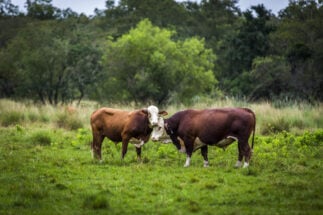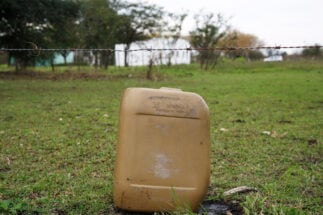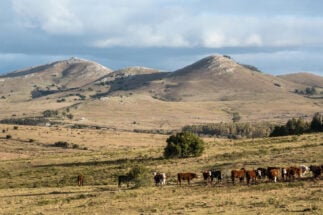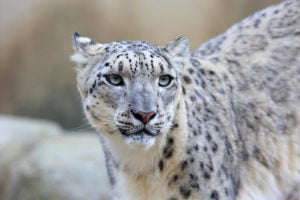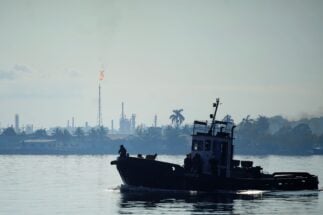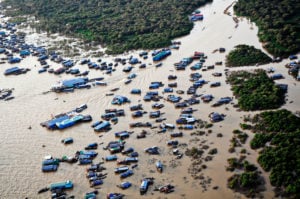In an era of climate crisis, and with a growing portion of international markets in search of guaranteed, verifiably sustainable food, Argentinian livestock farming is seeking to improve its productivity and traceability levels as a way to lessen its environmental impact.
The national livestock sector contributes 20.7% of Argentina’s total greenhouse gas output, mostly caused by emissions from bovine enteric fermentation – a process of digestion in cows from which the byproduct of methane is belched out. Livestock emissions are second only to the energy sector, with 54%.
Technicians and market analysts admit that there is room for improvement in the livestock sector, but argue that not only is Argentina’s livestock industry not a major emitter, but that it could also become neutral or even a sector with a positive impact.
To this end, they call for a review of the methodologies used to calculate Argentina’s emissions, and for the carbon captured in grasslands and pastures – on which most of the country’s livestock production is based – to be counted in favour of the sector.
This, however, is questioned by environmental organisations, which point to cattle ranching as the activity responsible for deforestation in the country’s northern provinces, especially since 2010. There is still a long way to go for the activity to be classified as sustainable, Greenpeace has said.
Forests, as well as wetlands, are important reservoirs of carbon dioxide, one of the main gases causing global warming. Worldwide, it is estimated that about 20% of global emissions originate from deforestation.
Livestock in Argentina
Argentina has around 52 million head of cattle, according to data from the Instituto de la Promoción de la Carne Vacuna Argentina (IPCVA). There are some 130,800 farms dedicated to cattle production, according to the latest National Agricultural Census.
52 million
The estimated head of cattle kept by livestock farmers in Argentina
The report “Carne Argentina, carne sustentable” published this year by the IPCVA specifies that more than half of the cattle herd is concentrated in the provinces of Buenos Aires, Córdoba and Santa Fe, Argentina’s core agricultural region. Pastures in this region are the basis for more than 50% of the country’s meat production.
Argentina produced some 3.17 million tonnes of meat in 2020, of which 900,700 tonnes were exported, 75% to China. This year, in the first three months – ahead of five months of limits and bans on exports – China remained the main destination, with 109,000 tonnes, followed by Israel with 11,000 tonnes and Chile with 8,300 tonnes.
Adrian Bifaretti is an agricultural engineer and heads the IPCVA’s domestic department. In his opinion, there are “mature” export markets in terms of sustainability, such as the European or, in part, the American market, where the demand for certain standards “is becoming increasingly strong”.
However, at the level of the Argentine domestic market, which consumes 70% of the meat produced, this consumer profile is not yet in place. “Some international markets are demanding environmental standards, but for now Argentinean buyers are not asking for this,” said Pablo Preliasco, head of the sustainable livestock programme of the Fundación Vida Silvestre Argentina, the Argentine Wildlife Foundation.
In China, the strengthening of sustainable consumption trends is driven by younger generations, who are concerned about both traceability and food safety standards. The 20–29 age group is the one that shows most interest in this.
For Fernando Vilella, director of the agribusiness and food programme at the University of Buenos Aires (UBA), although the overall percentage of the Chinese population that demands high-quality meat is still small, the emergence of more demanding young consumers could change the scenario.
“This requires a response in our exports of livestock, which must move towards certification and traceability schemes for these products,” Vilella added. “Livestock farming must build a national brand associated with low environmental impact production.”
Deforestation and bad practices
Environmental organisations point to cattle ranching as a main driver of “new” deforestation in Argentina, concentrated in four northern provinces: Formosa, Salta, Santiago del Estero and Chaco.
Hernán Giardini, coordinator of Greenpeace’s forests campaign, explained: “Today, cattle ranching is the main cause of deforestation in the country, and since 2010 more land has been cleared by cattle than by soya. When we look at the requests made for deforestation in the Gran Chaco, there are more for livestock than for agriculture.”
Cattle ranching is currently the main cause of deforestation, just as soy was in the 1990s and early 2000s
Greenpeace pointed to other environmental problems, including those associated with free-range meat. They argue that animal feed for these approaches is linked to GM crops and other unsustainable practices, such as animal confinement and water and soil contamination.
“Livestock farming is not sustainable in Argentina in most cases. It is a lie that it does not generate deforestation,” said Giardini. “It is currently the main cause of deforestation, just as soy was in the 1990s and early 2000s.”
Greenpeace’s 2020 annual report on deforestation in northern Argentina mentions that in the last decade this practice “was the main source of carbon emissions in northern Argentina”. The document states that in 2019 some 80,938 hectares were cleared. In 2020, the year of the pandemic, that area grew to 114,716 hectares, with emissions of more than 20 million tonnes of CO2 equivalent.
Observers may, however, be buoyed by announcements made at the UN’s COP26 climate summit in Glasgow, including the Glasgow Leaders’ Declaration on Forests and Land Use – to which Argentina was a signatory – that pledges to halt and reverse forest loss by 2030. Elsewhere, eight financial institutions committed US$3 billion in finance towards deforestation-free cattle production in South America, under the Innovative Finance for the Amazon, Cerrado and Chaco (IFACC) initiative.
Emissions a key issue
Is Argentina’s livestock prepared to meet new export market standards? According to IPCVA’s Bifaretti, the answer is positive.
“Our natural grassland system has a great capacity to store carbon and, if properly measured, more is stored than is emitted,” Bifaretti claims. “This is a fight for meaning and communication that the national livestock sector must fight with scientific support.”
For Argentina’s livestock sector, the main argument for questioning its supposed level of emissions is based on the fact that most production is done in natural pastures rather than on deforested, cleared land. Argentina’s pastures, according to the IPCVA specialist, have an amount of carbon stored in the soil equivalent to what the country emits in 74 years.
Accounting for the sector’s carbon sequestration, and not just its emissions, is the key to changing the image of livestock farming
Carbon accumulates as organic matter in the soil and can remain there for up to hundreds of years. Pastures contribute to this largely through the abundant amount of roots they produce. In this way, they can remove carbon from the atmosphere by sequestering it in the soil, and help to mitigate global warming.
“Accounting for the sector’s carbon sequestration, and not just its emissions, is the key to changing the image of livestock farming and even moving to a positive balance sheet. There is a scientific battle that the sector must fight,” said Bifaretti.
Developing countries are obliged to submit their greenhouse gas inventories to the UN every two years, based on methods suggested by the Intergovernmental Panel on Climate Change (IPCC).
There is general agreement in the scientific world on these methods. However, the best way to estimate carbon sequestration by forests and grasslands is still under debate. It is precisely this divergence that opens the debate from the livestock sector.
In a paper published in 2019, a group of Argentinean researchers concluded that the carbon sequestration capacity of grazing land is underestimated in inventories, and that these lands are generating a carbon surplus – meaning that the emissions produced by animals and production are potentially offset by the amount of carbon that grazing lands sequester.
Miguel Taboada, one of the authors of the paper, argues that grasslands store carbon at deeper depths than the 30 centimetres the IPCC acknowledges. There is also carbon in the root biomass of grassland plants, something that is also not considered by the IPCC methodology.
“It is a technical or even academic discussion that unfortunately, for some people, has become a political dispute. It is valid to discuss it,” Taboada added.
For Víctor Tonelli, a livestock market analyst and consultant, there is a gap between what the European consumer perceives and the reality of the Argentine system in which, he says, “the animal spends 85% of its life outdoors in fields with an average consumption that does not go below 90% grass”. It has been suggested that grass-fed cows have a lower carbon footprint than those fed on grain, by stimulating soil carbon sequestration through grazing, though this remains contested.
For advocates such as Tonelli, “There is a lack of scientific work published in international journals, a lack of awareness in government agencies and a lack of better communication” on the issue of grazing and emissions. He added that this was one of the reasons for the creation of the Argentine Roundtable on Sustainable Meat four years ago.
Conversion and traceability in Argentina’s livestock sector
According to Preliasco of the Fundación Vida Silvestre, completing the path towards more sustainable production does not require large investments on the part of producers. “Except for a few cases that work on deforestation or very large land conversion, most livestock production [in Argentina] is already sustainable, and the largest volume of meat production can already be termed as deforestation-free with ease,” the expert said.
On traceability, Tonelli mentioned that although “there is always room for improvement”, Argentina has a solid system. “It is a good system, but we need to digitalise it to reduce errors, make it faster and get QR codes on packages for the consumer.”
In addition, the IPCVA recognises that there is still a lot of room for improvement in terms of kilos of emissions per animal and per hectare. “If technology is improved, emissions per unit of product are reduced, but there is still a technological gap to be filled,” said Bifaretti, for whom this would not require large investments. What is needed more than this input, he says, is to improve the management of grazing systems.
For Preliasco, the main priority is to stop deforestation and the conversion of ecosystems, and focus on stock numbers: “In Argentina, we haven’t increased the cattle stock for decades. A long-term policy could be to maintain current levels so as not to increase emissions.”

